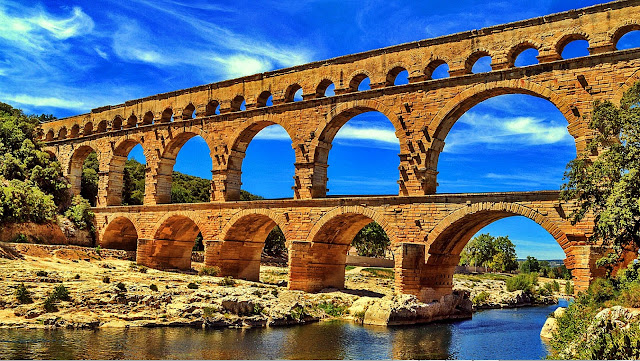Friday, April 7, 2023
The History of Concrete
Concrete is a composite material composed of coarse aggregate bonded together with a fluid cement that hardens over time.
Small usages of concrete go back for thousands of years. Concrete-like materials were used since 6500 BC by the Nabataea traders or Bedouins who occupied and controlled a series of oases and developed a small empire in the regions of southern Syria and northern Jordan. They discovered the advantages of hydraulic lime, with some self-cementing properties, by 700 BC. They built kilns to supply mortar for the construction of rubble-wall houses, concrete floors,
and underground waterproof cisterns. The cisterns were kept secret and were one of the reasons the Nabataea were able to thrive in the desert. Some of these structures survive to this day.
The Egyptians were using early forms of concrete over 5000 years ago to build pyramids. They mixed mud and straw to form bricks and used gypsum and lime to make mortars.
Archaeologists found concrete floors, which were made of lime and pebbles, in the royal palace of Tiryns, Greece, which dates roughly to 1400–1200 B.C.. Lime mortars were used in Greece, Crete, and Cyprus in 800 BC. The Assyrian Jerwan Aqueduct built in 688 B.C. was made using waterproof concrete.
The earliest large-scale users of concrete technology were the ancient Romans, and concrete was widely used in the Roman Empire. Romans discovered that adding volcanic ash to the mix allowed it to set underwater. Similarly, the Romans knew that adding horse hair made concrete less liable to crack while it hardened, and adding blood made it more frost-resistant. Crystallization of strätlingite and the introduction of pyroclastic clays creates further fracture resistance.
The Romans used concrete extensively from 300 BC. for more than seven hundred years. During the Roman Empire, Roman concrete (or opus caementicium) was made from quicklime, pozzolana and an aggregate of pumice. It freed Roman construction from the restrictions of stone and brick material and allowed for revolutionary new designs in terms of both structural complexity and dimension.
The widespread use of concrete in many Roman structures ensured that many survive to the present day. The Baths of Caracalla in Rome are just one example. Many Roman aqueducts and bridges such as the magnificent Pont du Gard have masonry cladding on a concrete core, as does the dome of the Pantheon. The Roman Pantheon was the largest dome in the world for more than a millennium and is the largest unreinforced solid concrete dome to this day.
After the Roman Empire, the use of burned lime and pozzolana was greatly reduced until the technique was all but forgotten between 500 and the 14th century. From the 14th century to the mid-18th century, the use of cement gradually returned. The Canal du Midi was built using concrete in 1670.
Perhaps the greatest driver behind the modern usage of concrete was Smeaton's Tower, the third Eddystone Lighthouse in Devon, England. To create this structure, between 1756 and 1759, British engineer John Smeaton pioneered the use of hydraulic lime in concrete, using pebbles and powdered brick as aggregate.
In 1824 Joseph Aspdin invented the modern Portland cement. He named his cement Portland, after a rock quary that produced very strong stone.
In 1836, the first test of tensile and compressive strength took place in Germany. Tensile strength refers to concrete's ability to resist tension, or pulling apart forces. Compressive strength refers to concrete's ability to resist compression, or pushing together forces.
In 1849 Joseph Monier invented the reinforced concrete. Reinforced concrete is a composite material in which concrete's relatively low tensile strength and ductility are counteracted by the inclusion of reinforcement having higher tensile strength or ductility. The reinforcement is usually, though not necessarily, steel reinforcing bars and is usually embedded passively in the concrete before the concrete sets. Reinforcing schemes are generally designed to resist tensile stresses in particular regions of the concrete that might cause unacceptable cracking and/or structural failure.
In 1889 was built Alvord Lake Bridge, the first reinforced concrete bridge, in San Francisco. The bridge still exists today, over one hundred years after it was built.
In 1893, Court Avenue, a small street in downtown Bellefontaine, Ohio, became the first street in the United States to be paved with concrete.
In 1903, the first concrete high rise was built in Cincinnati, Ohio. The Ingalls Building, as it is called, has sixteen stories, making it one of the great engineering feats of its time.
In 1908, Thomas Edison designed and built the first concrete homes in Union, New Jersey. These homes still exist today. Edison envisioned that his design would meet great success, and that before no time everyone in America would be living in a concrete home.
In 1913 the first load of ready mix was delivered in Baltimore, Maryland. The idea that concrete could be mixed at a central plant, then delivered by truck to the job site for placement, revolutionized the concrete industry.
In 1930, air entraining agents were used for the first time in concrete to resist against damage from freezing and thawing.
In 1936 was completed the Hoover Dam, located on the Colorado River, bordering Arizona and Nevada. Up to this time, the dam was the largest scale concrete project ever completed.
In 1967 was built the first concrete domed sports arena, known as the Assembly Hall, at the University of Illinois.
In 1999 was the first installation of a polished concrete floor in the US, which was a 40,000-square-foot warehouse floor for the Bellagio in Las Vegas.
In 2009 was built the tallest reinforced concrete building, in Dubai, United Arab Emirates. The 154-story building is called Burj Khalifa and it has a total height of 829 meters.
















